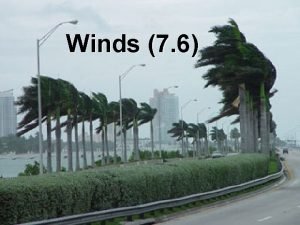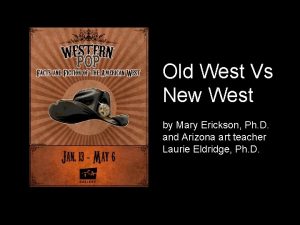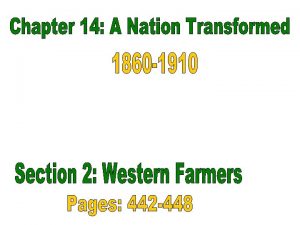Economic Development of the West 442 443 During















- Slides: 15


• Economic Development of the West: (442 -443) – During the Civil War, Republicans tried to manage western development so that new western states and territories would be free of slavery – The Republicans wanted these areas to be populated by independent farmers who would improve the land – After the Southern States had seceded from the Union, Republicans passed a series of acts in 1862 to turn public lands into private property

• Economic Development of the West: (442 -443) – Land Acts: (442) • 1. 2. 3. Three government land acts increased non -Indian settlement of the Great Plains The Homestead Act: permitted “any citizen or intended citizen to select any surveyed land up to 160 acres and to gain title to it after five years’ residence” if the person cultivated the land – eventually some 400, 000 families took advantage of the offer Pacific Railway Act: gave lands to railroad companies to develop a railroad line linking the East and West coasts. The Morrill Act: granted a total of more than 17 million acres of federal land to the states. The act ordered the sale of this land to finance the construction of agricultural and engineering colleges. This act led to the eventual founding of more than 70 state universities

• Economic Development of the West: (442 -443) – Land Acts: (442) • Competition for land was fierce. • In October of 1889, a flood of prospective settlers responded to a government offer of inexpensive homesteads in Oklahoma • The acreage came from former Creek and Seminole lands • This occurred at the expense of American Indians, who lost more than 11 million acres in Oklahoma to non-Indian settlers

• Economic Development of the West: (442 -443) – The Railroads: (443) • Railroad companies also lured settlers to the West. • Between 1869 and 1883, four rail lines were built across the West • The Pacific Railway Act: the U. S. government had given railroad companies more than 125 million acres of public land • Government officials believed that railroad companies would promote western settlement and economic growth • The Homesteaders benefited from the nearby railroad lines, using them to ship their crops to distant markets • Eager to encourage settlement along their rail routes, railroad companies advertised in the East and in Europe

• Moving West: (443 -444) – Three main groups traveled westward after the Civil War: white Americans from the East, African Americans from the South, and immigrants from foreign countries. Some sought economic opportunity and others hoped to find racial tolerance – For African Americans, moving west offered a chance to escape the violence and persecution they faced following the withdrawal of federal troops from the South in 1877. – Exodusters: African American settlers who trekked west, following leaders such as Benjamin Singleton, a 70 -year-old former slave. – The biggest exodus, or mass departure, of black settlers with so-called Kansas fever occurred in 1879 because that is where John Brown had fought slavery

• Moving West: (443 -444) – European immigrants also flocked to the West. AMERICAN FEVER – Many of the Chinese immigrants who had come to the United States during the California Gold Rush had also turned to farming by 1880. Throughout the west

• Western Environments and Farming: (444 -445) – Although settlers homesteaded some 80 million acres of public land in the Great Plains between 1862 and 1900, the region did not immediately prosper – Supplies were expensive, and the environment posed problems for farmers

• Western Environments and Farming: (444 -445) – Scarce Resources: Water was in short supply throughout the West – In parts of the Southwest, Hispanic and American Indian farmers developed effective irrigation systems and used canals, dams, and sloping fields to control water flow. – The Great Plains had fewer water sources. Many farmers had to travel several miles to a river or stream where they would fill large barrels and haul them back to the farm – Farmers used new kinds of windmills to draw water from their wells

• Western Environments and Farming: (444 -445) – Scarce Resources: TREES – Trees were another scarce resource on the Great Plains – Settlers developed clever solutions to cope with the lack of wood for fuel or building materials – Settlers built: sod houses, which were buildings made from chunks cut from heavy topsoil that were stacked like bricks – Sod Houses were damp and dirty. The roofs leaked and even collapsed in rainy weather. – Dirt in your food

• Western Environments and Farming: (444 -445) – Scarce Resources: • Created in 1862, the U. S. Department of Agriculture (USDA) helped farmers adapt to their new environment. • USDA experts sought out and publicized new varieties of wheat suitable for the Great Plains • USDA also began teaching dry farming – new planting and harvesting techniques that conserved moisture

• Western Environments and Farming: (444445) – New Farming equipment: (445) • Many of the new farming devices used steam-powered engines. However, the new technology plunged many small farmers into debt when they bought the equipment necessary to compete with larger landholders • Efficient new farm machinery and cheap, abundant land enabled some companies to create a new kind of large-scale operation – the Bonanza Farm • Most bonanza farms were owned by large companies and were operated like factories, with machinery, professional managers, and specialized laborers for different tasks • Migrant workers, who were often unemployed cowboys performed much of the seasonal labor • Bonanza farms were not always successful

• Farm Life on The Plains: (447448) – Harsh Weather and Hard Work – Weather: the climate of the Great Plains caused hardships for families. – Winters on the Great Plains often brought blizzards an bone-chilling winds, and the summer heat could be fierce – Insects: also created a problem on the Great Plains. – In the 1870 s farmers faced swarms of grasshoppers that devoured everything in their path, even the wooden handles of farming tools – Raging fires sometimes swept across the Great Plains – Farming was demanding work on everyone in the family

• Storytellers of the Plains: (448) – Western writers recorded stories about life on the Great Plains. – Willa Cather, born in Virginia in 1873, was one such writer. In her book she wrote about how fascinating it was to live in The Great Plains – Nebraska

 Economic growth vs economic development
Economic growth vs economic development Conclusion of growth and development
Conclusion of growth and development Experiment 443 taps
Experiment 443 taps Din en 443 feuerwehrhelme
Din en 443 feuerwehrhelme A man named bungkas climbed a palm tree
A man named bungkas climbed a palm tree How to round to the nearest metre
How to round to the nearest metre 574-173-443
574-173-443 West north west wind direction
West north west wind direction West north west wind direction
West north west wind direction Windrichtingen wereld
Windrichtingen wereld East is east and west is west
East is east and west is west Old west vs new west
Old west vs new west Eecs 442
Eecs 442 Compiler design tutorial
Compiler design tutorial Comp 442
Comp 442 Psalm 73 liedboek
Psalm 73 liedboek




























